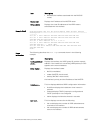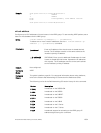
Line Beginning
with
Description
• UP or DOWN state of the tracked interface or object (Up
or Dn).
• Interface type and slot/port or object number,
description, and time since the last change in the state of
the tracked object.
• Cost to be subtracted from the VRRP group priority if the
state of the tracked interface/object goes DOWN.
Example
Dell#show vrrp ipv6
------------------
TenGigabitEthernet 5/6, IPv6 VRID: 255, Version: 3, Net:
fe80::201:e8ff:fe7a:6bb9
VRF: 0 default-vrf
State: Master, Priority: 101, Master: fe80::201:e8ff:fe7a:6bb9
(local)
Hold Down: 0 centisec, Preempt: TRUE, AdvInt: 100 centisec
Accept Mode: FALSE, Master AdvInt: 100 centisec
Adv rcvd: 0, Bad pkts rcvd: 0, Adv sent: 64
Virtual MAC address:
00:00:5e:00:02:ff
Virtual IP address:
1::255 fe80::255
vrrp-ipv6-group
Assign an interface to a VRRP group.
Syntax
vrrp-ipv6-group vrid
Parameters
vrid Enter the virtual-router ID number of the VRRP group. The
VRID range is from 1 to 255.
Defaults Not configured.
Command
Modes
INTERFACE
Command
History
This guide is platform-specific. For command information about other platforms,
refer to the relevant Dell Networking OS Command Line Reference Guide.
The following is a list of the Dell Networking OS version history for this command.
Version Description
9.7(0.0) Introduced on the S6000-ON.
8.4.2.1 The range of valid VRID values on the E-Series when VRF
microcode is loaded in CAM changed from 1 to 15.
8.4.1.0 Introduced on the E-Series ExaScale, C-Series, and S-Series.
Virtual Router Redundancy Protocol (VRRP)
1909


















